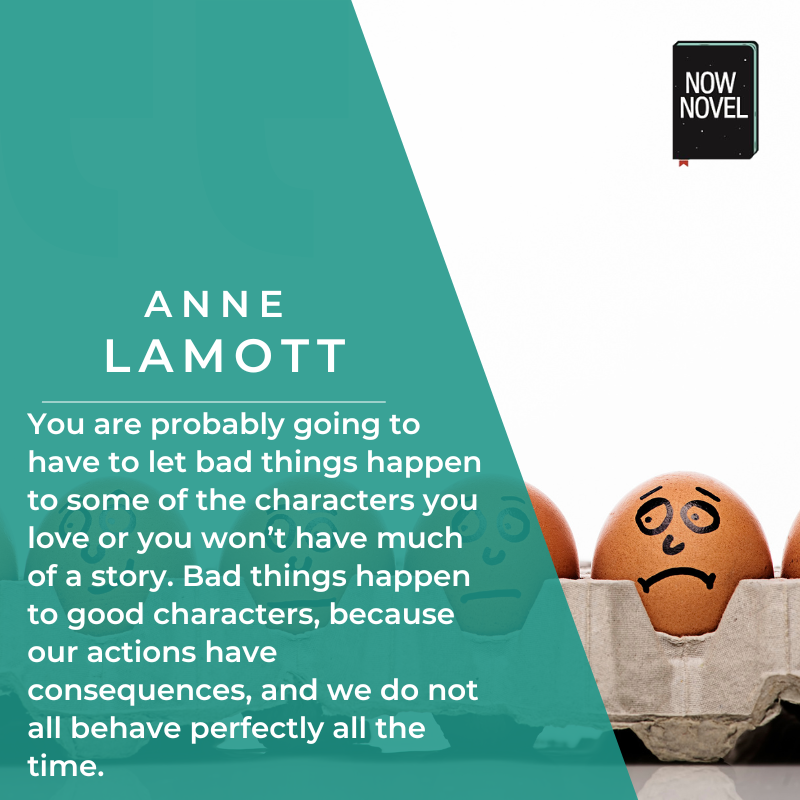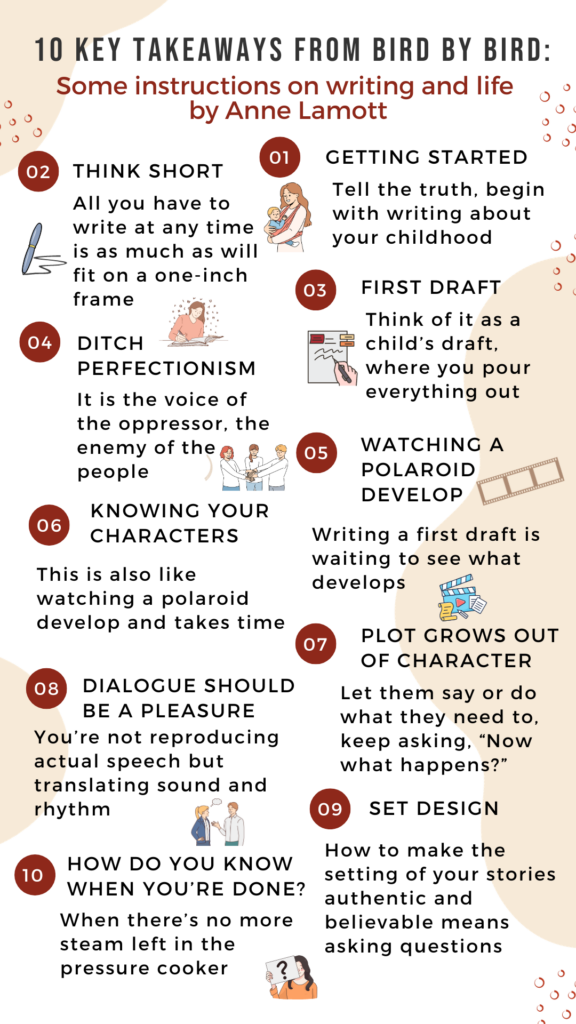Here are 10 key takeaways from a book that has become iconic: Bird by Bird: Some Instructions on Writing and Life by memoirist and novelist Anne Lamott. It’s been nearly three decades since it was published in 1994. In the years since it’s become something of a cult book, recommended by writing teachers, read by students of writing, and has even been revised from its original publication and gone into numerous printings.
What makes it such a great book, though? Besides Lamott’s fantastic sense of humour, which elevates this text beyond mere instruction, this one has some real and useful down-at-home honesty about the writing process.
Let's look at the 10 takeaways as they relate to the crafting of fiction from Bird by Bird: Some Instructions on Writing and Life.
1. Getting started
Lamott is an experienced writing teacher, and this book shares information that she tells her writing students. One of the first bits of advice is: "The very first thing I tell my new students on the first day of a workshop is that good writing is about telling the truth."
This comes from the fact that many of her students say that they don’t know where exactly to start. Lamott says to start with writing about their childhoods. She says to write down all your memories, as truthfully as you can, without worrying about getting it done well.
The danger is that there might be too many memories and details with the resultant “brain freeze.” in this case, she suggests confining yourself to writing about your first few years in kindergarten moving on to first grade and so on. Write down your vacations, focus on big holidays and big events, birthday parties, what people ate or what they wore.
As to how to physically start, Lamott’s advice is simple:
You sit down, I say. You try to sit down at approximately the same time every day. This is how you train your unconscious to kick in for you creatively. So you sit down at, say, nine every morning, or ten every night. You put a piece of paper in the typewriter, or you turn on your computer and bring up the right file, and then you stare at it for an hour or so.
2. Think short
Here’s where some of the "bird by bird" advice comes in. Incidentally this piece of advice comes from Lamott’s father, Kenneth, who was also a working writer. Lamott’s brother was once overwhelmed by an assignment on birds, and her father said to him to take it "bird by bird."
Lamott says to take it little by little in short bites:
The first useful concept is the idea of short assignments. Often when you sit down to write, what you have in mind is an autobiographical novel about your childhood, or a play about the immigrant experience, or a history of—oh, say—say women. But this is like trying to scale a glacier.
It reminds me that all I have to do is to write down as much as I can see through a one- inch picture frame. This is all I have to bite off for the time being. All I am going to do right now, for example, is write that one paragraph that sets the story in my hometown, in the late fifties, when the trains were still running.
So, instead of thinking, “I have to write 300 pages or 100,000 words” tell yourself you just have to write this chapter, or, as Lamott says, “…this description of the river at sunrise … or the first time the man sees the woman he will marry … But we are going to finish this one short assignment.”

3. First draft is a child’s draft
Terrible name, and that's perhaps the point, but we’re all familiar with the term “shitty first drafts.” Lamott says this is “even better news” than the idea of short assignments. All writers have to complete such drafts, she advises, which is how writers end up with second drafts and terrific third drafts.
The idea here is that:
The first draft is the child’s draft, where you let it all pour out and then let it romp all over the place, knowing that no one is going to see it and that you can shape it later. You just let this childlike part of you channel whatever voices and visions come through and onto the page. If one of the characters wants to say, “Well so what, Mr. Poopy Pants,” you let her.
Just get it all on paper is Lamott’s dictum, you never know what might emerge and what might be useful in those pages. You might produce some beautiful writing which will lead to other beautiful writing—or not. Worth noting, too, is that Lamott also points out that writing is its own beautiful reward.
4 Ditch perfectionism
Another really good piece of advice from Bird by Bird is to ditch perfectionism. It will, says Lamott, “ruin your writing and playfulness and life force. … Perfectionism means that you try desperately not to leave so much mess to clean up. But clutter and mess show us that life is being lived.”
In this delightful chapter, Lamott shows is at pains to get the message across that writing—like life—is messy. An important point to remember when you sit down in front of that screen.
5. Watching a Polaroid develop
Lamott presents the analogy that writing a first draft is like watching a polaroid develop. In other words you’re not going to know what comes out of your pen until you’ve written it. She writes about how details of a story emerge the longer you look, and as you look around at the world you’ve created.
To illustrate this point, she recounts a time when she was asked to write an article on the Special Olympics. A tall African American man fell into step with her and handed her a Polaroid of himself with two friends who had Down’s syndrome. Pointing to his own image, he said, “That is one cool man.” And that was when the story started coalescing in her mind, from that one image that had been handed to her.
6. Knowing your characters
In discussing character, Lamott returns to the example of the Polaroids, saying that it takes time to get to know them.
She says that we are all born with an emotional arc—and so it is with every character you write. And this is what you want to discover about your characters. An emotional arc is the list of changes that a character undergoes through a story, and can include “Boy meets girl” or “a Cinderella, rags to riches story.”
The point is to discover as much as possible about the interior life of your characters, and discover such things as who they voted for in the last election, or what would they stop doing if they found out they had six months to live and so on.
Interestingly, Lamott speaks about the fact that writers’ characters come from within each writer:
You are going to love some of your characters, because they are you or some facet of you, and you are going to hate some of your characters for the same reason. But no matter what, you are probably going to have to let bad things happen to some of the characters you love or you won’t have much of a story. Bad things happen to good characters, because our actions have consequences, and we do not all behave perfectly all the time.
Your characters are shaped by who they are, and you can dig deep into discovering them by looking within. And if you are struggling to write a character that you are, not this advice is a way of accessing that:
One way to do this is to look within your own heart, at the different facets of your personality. You may find a con man, an orphan, a nurse, a king, a hooker, a preacher, a loser, a child, a crone. Go into each of these people and try to capture how each one feels, thinks, talks, survives.
Lamott also says that narrators should be likeable, quoting the American writer and educator Ethan Canin who said, “Nothing is as important as a likable narrator. Nothing holds a story together better.” A reliable narrator is another must, that they are not playing games or being coy but that they are telling their truth. And, finally, remember that getting to know your characters takes time.
Read our useful guide to character questions for over 100 questions to ask your characters to deepen your story arc.

7. Plot grows out of character
This next point links directly to that of character, and Lamott gives some wise advice in this respect and one of the simplest, yet effective descriptions of plot:
"Plot grows out of character. If you focus on who the people in your story are, if you sit and write about two people you know and are getting to know better day by day, something is bound to happen."
However,
Characters should not, conversely, serve as pawns for some plot you’ve dreamed up. … I say don’t worry about plot. Worry about the characters. Let what they say or do reveal who they are, and be involved in their lives, and keep asking yourself, Now what happens? The development of relationship creates plot.
Her thoughts are to find out what motivates each character, what they care about most, because then you will have discovered what’s at stake for them. Find a way to express this discovery in action, and take them from good to bad and so on. Something must be at stake, though, to create tension. By closely observing your characters and watching them move around in the world, you will see what they are capable of.
She also compares plot to that of telling a joke: “Drama is the way of holding the reader’s attention. The basic formula for drama is setup, buildup, payoff—just like a joke. The setup tells us what the game is. The buildup is where you put in all the moves, the forward motion, where you get all the meat off the turkey. The payoff answers the question, Why are we here anyway? What is it that you’ve been trying to give?”
Sometimes Lamott hasn’t always known what the plot of her fiction will be, just the shiny bulbs of ideas, but staying with her characters and seeing how they interact with each other has shown her what their story is.
Quoting John Gardner, she writes that “the writer is creating a dream … and that it must be vivid and continuous.” Asking others to read your work is another important point that is detailed in this chapter, as you can’t always see the problems in your own work.
Get to grips with plot by taking a course in how to plot a story, which will show you how to start and develop a plot line.
You sit down, I say. You try to sit down at approximately the same time every day. This is how you train your unconscious to kick in for you creatively.—Anne Lamott
8. Dialogue is a pleasure
Dialogue in a story represents a change of pace from description and exposition, and says Lamott, “And we have all the pleasures of voyeurism because the characters don’t know we are listening. We get to feel privy to their inner workings without having to spend too much time listening to them think.”
There is a danger though in writing bad dialogue which can “break the mood of a piece.” Lamott gives some good advice on this score, saying dialogue is not an exact reproduction of the way people speak, that it’s a “matter of ear. … You’re not reproducing actual speech—you’re translating the sound and rhythm of what a character says into words. You’re putting down on paper your sense of how the characters speak.”
Dialogue is more like a movie than it is like real life, since it should be more dramatic. There’s a greater sense of action. In the old days, before movies, let’s say before Hemingway, the dialogue in novels was much more studied, ornate. Characters talked in ways we can’t really imagine people talking. With Hemingway, things began to terse up. Good dialogue became sharp and lean. Now, in the right hands, dialogue can move things along in a way that will leave you breathless.
As to how to create this good dialogue? Read your dialogue aloud and listen to people talking when you’re out in the world. Also, each character should be identified by what they say, and they should all sound quite different from each other. It’s “the way to nail character” and a vital part of any story.
If you'd like help with "nailing" your characters, consider doing our course in dialogue writing. It consists of four modules with videos, guides and valuable feedback.

9. Set design
Sometimes your characters may need to “wait in the wings” while you work out the setting of your fiction. Imagine you’re setting the stage for their appearance. This means working out where they live, and if they have money, what sort of furniture they have and so on. Lamott recalls working on a book where her character loved gardening—but Lamott is a known plant killer. She talked to the experts, and when her novel came out readers assumed she was as avid a gardener as her character, which wasn’t the case, of course, even after all her research. She had reached out to an expert who had helped her design a fictional garden. And has continued to reach out to experts when setting her characters in places she has never been.
10. How do you know when you’re done?
Lastly, how do you know when you are done? Writes Lamott, “I don’t quite know how to answer it. You just do.” After having gone over your work numerous times, rewritten it, taken suggestions on board, “and then finally something inside you just says it’s time to get onto the next thing.”
You know that your manuscript is not perfect and you’d hoped for so much more, but if you also know that there is simply no more steam in the pressure cooker and that it’s the very best you can do for now—well? I think this means that you are done.
Here are the 10 key takeaways as they relate to go about crafting your fiction. Lamott also has lots to say around how to "live" that writer's life. She looks at topics such as finding someone to read your work, finding a writers group, dealing with self-doubt and a whole lot more. It's well worth a read.











Plot Driven or Character Driven? The eternal question. My answer leans toward the joy of writing through character development. Draft Zero is character driven with dialogue advancing the story but this is much too slow for most readers and they don't grasp the subtle. Draft One adds pivotal incidents that force characters to make tactical responses. This sometimes forces characters to change the story. This is pure "Bird by Bird". When a bird becomes tired, shoot it.
Rex Fury - About 2 years ago
Dear Rex, thanks for your comments. I like that term 'Draft Zero'. I also think this a wonderful way of writing a novel, great idea!
Arja Salafranca - About 2 years ago
Why should I read about writing from someone who constructs this sentence beginning: "As a long-time writing teacher, this book delivers..."
Grumpy Gus - Almost 2 years ago
You make a good point, that sentence is awkward. I've updated the blog. Thank you for pointing this out.
Arja Salafranca - Almost 2 years ago